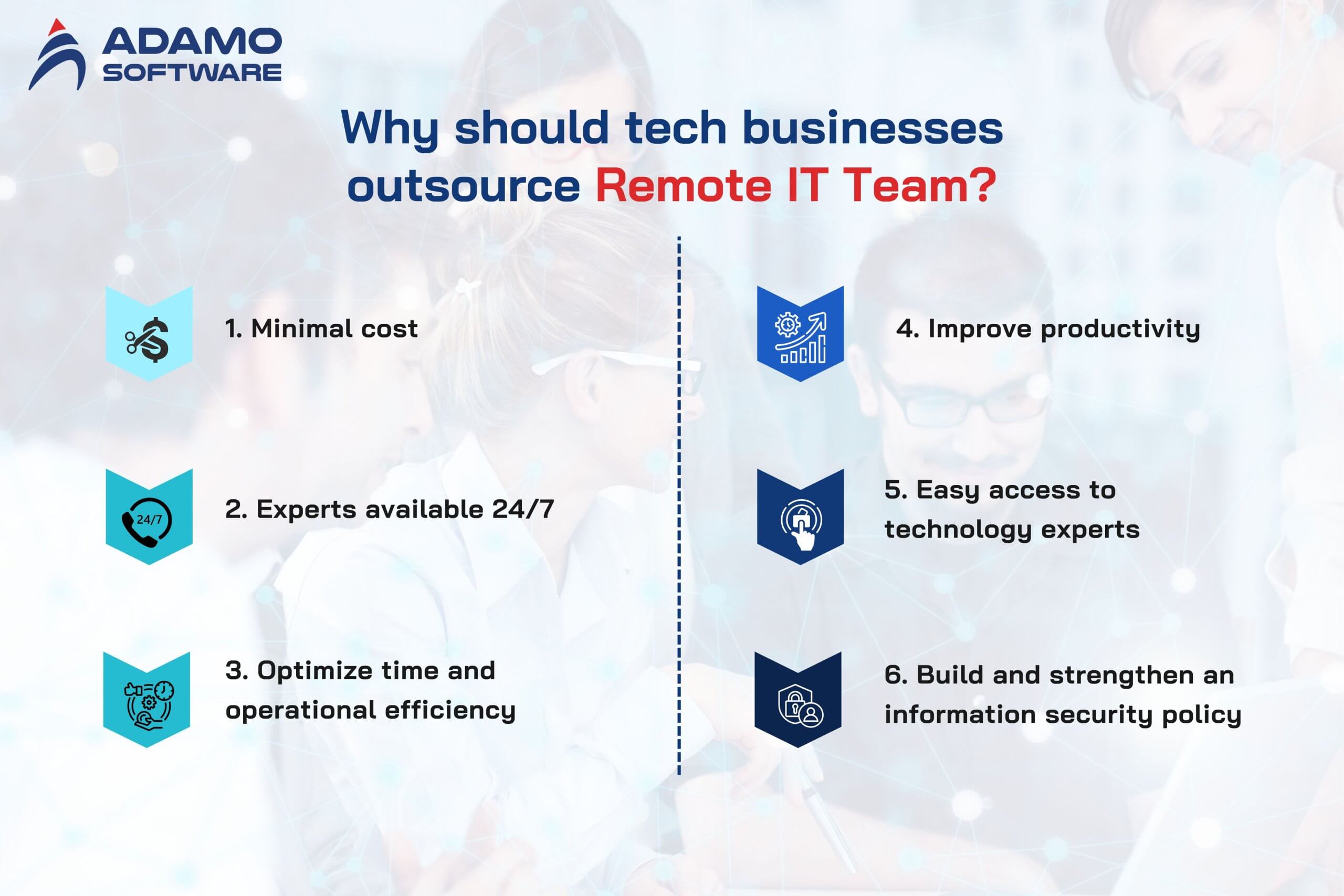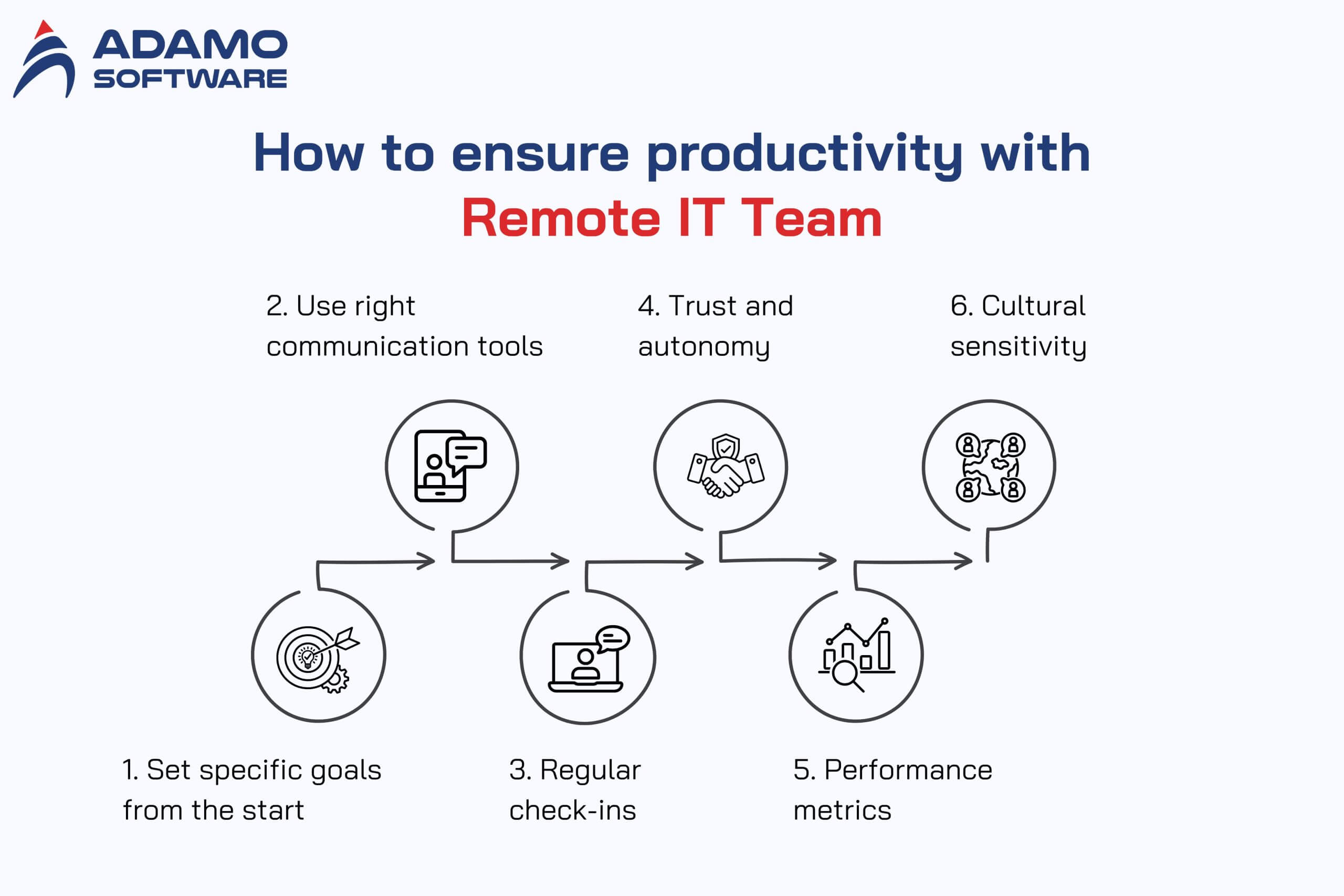Outsourcing a Remote IT Team: What Tech Businesses Must Know

Explore the benefits and challenges of outsourcing remote IT team. Learn how Adamo Software’s expert services can boost productivity and security for your business.
In the booming digital age, remote working has become increasingly popular in the technology industry. Especially since the pandemic, the option of outsourcing remote IT teams has become an increasingly common expectation among businesses.
Along with the outstanding advantages, this solution also poses some challenges. It is essential to address these challenges proactively. They help technology companies maximize the benefits of remote working, promoting productivity, innovation, and sustainability.
In this article, let’s look at the benefits and challenges of outsourcing remote IT teams to understand better and tips for managing your remote IT team more easily.
I. Why should tech businesses outsource Remote IT Team?
In the context of technology increasingly playing a core role in business development, many companies, especially small and medium enterprises, have outsourced remote IT support services. This is a strategy to save costs, optimize resources, and maintain stable operations. Here are some convincing reasons for this decision:

1. Minimal Cost
Not every company has an internal IT team. Building an IT team requires businesses to pay high salaries, high training costs, and benefits, and invest in infrastructure. This is a big burden for start-up businesses with limited budgets. Meanwhile, outsourcing a remote IT team helps you only pay a fixed monthly fee while still ensuring professional, continuous service without worrying about additional costs.
2. Experts available 24/7
Technical problems can happen at any time, and sometimes internal staff cannot be present to handle them on time. Therefore, depending on a single individual, business operations can stagnate when a system fails. On the contrary, with remote IT outsourcing services, you always have a team of technicians ready to provide 24/7 technical support to help ensure stable system operation, quickly fix any problems, and minimize risks.
3. Optimize time and operational efficiency
“Time is money” for every business. Instead of dispersing resources to handle IT problems, which is not the company’s strength, entrusting it to a specialized unit will help you focus on the main goal: improving service, customer care, and business development. All technical problems are handled quickly, contributing to maintaining smooth and continuous operations.
4. Improve productivity
Productivity is a key factor for business success. Employees who do not have to deal with common IT issues, such as software or network connection errors, will have more time to focus on their professional work.
Hiring a remote IT support team will provide direct technical support, quickly handle incidents, and minimize downtime, greatly affecting work performance. At the same time, it increases productivity and quality of work.
Also read: The hidden costs of building an In-House Tech Team—and Smarter Alternatives
Explore Our Tailor-made Software Development Solutions
We are confident in providing end-to-end software development services from fully-functioned prototype to design, MVP development and deployment.
5. Easy Access to Technology Experts
Technology constantly evolves, so your organization’s skilled IT professionals must stay current. They must be familiar with the latest software updates relevant to your IT operations. While a dedicated in-house team of IT professionals will be willing to upgrade, they sometimes can’t keep up with the rapid pace of technological change.
On the other hand, remote IT support providers often have certified professionals who are constantly trained and updated on new trends. This gives businesses easy access to in-depth technology advice that is relevant and optimized for their business model.
6. Build and strengthen an information security policy
Cybersecurity is vital to any business. Remote IT service providers can not only provide technical operational support, but they can also design and implement security policies, disaster recovery plans, and risk mitigation solutions – a necessary layer of protection in an increasingly sophisticated and complex cyber threat landscape.
II. Challenges in remote IT team
While outsourcing IT services offers many benefits to businesses, it is not without its challenges. Here are the three most common challenges when working with a remote IT team and suggested practical solutions.
Challenge #1: Security Issues
Most reputable IT service providers will have the technology and protocols to protect your business. However, this does not guarantee protection against fraudsters. Businesses can still face threats like data breaches, cyber-attacks, and careless user behavior. For example, employees using weak passwords or accessing public Wi-Fi networks can leave the company’s firewall vulnerable.
Suggested solutions:
- Invest in and deploy a VPN (Virtual Private Network) for your workforce.
- All employees are required to change their passwords regularly and use password management tools.
- Set up multi-factor authentication (2FA) for an extra layer of security.
Challenge #2: Communication issues
Internal IT teams can physically assist employees by troubleshooting and resolving issues directly on their computers. Remote IT teams may have difficulty communicating complex technical problems, especially without visuals or direct access to equipment.
Suggested solutions:
- Invest in support tools like conferencing, video calling, and remote desktop sharing. These technologies make it easier for technicians to communicate with employees.
Challenge #3: Inefficient Service Delivery
Maintaining service quality is one of the biggest concerns for companies considering outsourcing tasks. This is particularly important when business heavily depends on technical systems. But with just a few established protocols and the right technology support, your IT outsourcing team can provide top-notch service to your company.
Suggested solutions:
- Ensure that all employees in your company are equipped with the software and hardware they need to do their jobs well.
- Set specific KPIs to measure and monitor the quality of third-party services.
III. How to ensure productivity with remote team in IT outsourcing

1. Set Specific Goals from the Start
To ensure your remote IT team is effective, you need to set clear goals from the get-go. Each team member must understand their role and how their work contributes to the project’s overall success. This clear goal setting helps prevent ambiguity and keeps the team on track.
Reviewing goals regularly in team meetings also helps maintain alignment and allows team members to ask questions or seek clarification.
2. Use the right communication tools
Communication is a key element of any remote team. Therefore, you must choose the right tools that facilitate seamless interaction between members, such as online meeting software, group chat, or work management platforms, to ensure that information is communicated clearly and quickly. Note that these tools must be reliable and easy to use.
In addition, encourage everyone to maintain regular communication throughout the work process. This also helps to bridge the gap between remote team members and create a more collaborative atmosphere.
3. Regular Check-Ins
Regular check-ins are an important activity for monitoring remote IT teams. Whether it’s a team meeting or a 1:1 meeting, progress is discussed, obstacles are identified, and feedback is provided. These sessions are an opportunity to keep you updated on the project’s progress and provide a platform for team members to voice concerns or share ideas.
They also provide opportunities for remote IT teams to share ideas, provide feedback, or provide feedback on workflows. This consistent engagement is critical to building trust and ensuring everyone feels supported and valued.
4. Trust and Autonomy
While supervision is important, a remote work environment requires balancing supervision and empowerment. You need to provide them with a degree of autonomy. Micromanagement can be demotivating when working remotely. Instead, set expectations around goals and deadlines and give your team the space to achieve these goals in their way. This approach can encourage autonomy, leading to increased productivity and job satisfaction.
5. Performance Metrics
To ensure productivity doesn’t slip, implement performance metrics that are tailored to remote work. These metrics should be fair, transparent, and reflect both individual and team contributions. They can include factors like the quality of work, adherence to deadlines, and collaborative efforts. Regularly reviewing these metrics with your team can help identify areas for improvement and celebrate successes, which is important for morale and motivation.
6. Cultural Sensitivity
Finally, cultural sensitivity is important when working with remote IT teams from multiple countries. This means understanding and respecting different work styles, time zones, and specific communication preferences and habits.
These cultural differences can improve team dynamics and prevent unwanted misunderstandings. You should encourage cultural exchange and learning among team members. This enhances collaboration and leads to a more inclusive work environment.
IV. Tips to makes managing Remote IT Team easier
Ultimately, it’s important to create the right conditions for your remote IT team to work effectively and in sync with a common goal. Even though you may have been leading a remote team for years and even if you are a veteran, there are bound to be challenges. Here are some tips to help you manage your remote IT team more easily:
1. Invest the Right Tools to Manage Remote Projects
The first tip you can apply is to invest in remote project management software for your team. With the right project management software in place, businesses can streamline collaboration and keep remote IT teams aligned, productive, and on track.
You can look for tools that support collaboration, communication, and task tracking, such as Trello, Asana, or Basecamp. These systems act as a virtual meeting place or office. They help keep your team organized, aligned, and accountable, especially when members are not working in a single time zone. You will immediately see improvements in your team as you streamline processes and improve overall productivity.
Ready to Outsource?
Discover how we can transform your business with expert IT solutions.
2. Consider outsourcing your talent
Outsourcing your IT talent is an easy and effective way to manage. This way, you can select programmers from a wider pool of skilled professionals for your team. Additionally, this will provide you with workers so that you don’t have to worry about training as much. It also leverages your company’s workflow to make it easier to manage your remote team.
V. Embracing Adamo Software’s outsourcing remote IT expertise

At Adamo Software, we accompany your business with a team of dedicated IT experts who are always ready to provide support remotely 24/7. Whether you are a startup or a large corporation, we are flexible across time zones. We can handle technical problems in just minutes, ensuring the system is always stable and secure.
We provide remote IT services across many sectors, including finance, healthcare, tourism – hotels, e-commerce, education, logistics, and other industries. Not only solving immediate problems, the Adamo team also proactively consults, monitors, and implements solutions suitable for the business’s long-term goals. If you are looking for a flexible, experienced, and cost-effective remote IT team, Adamo is the reliable choice.











